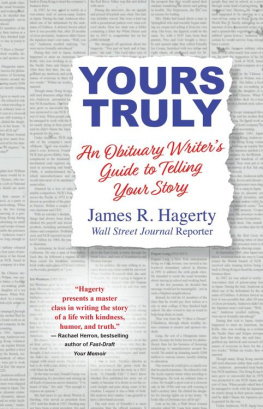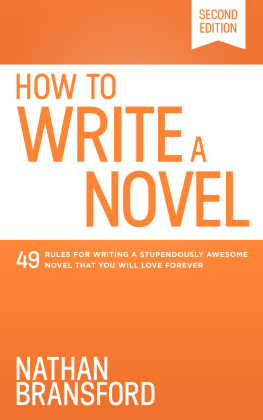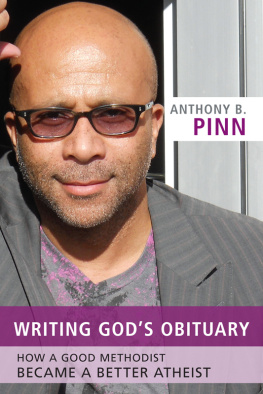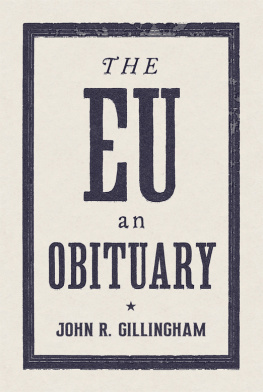How to Write an Obituary
A Step-by-Step Guide
HOW TO WRITE AN OBITUARY: A STEP-BY-STEPGUIDE
COPYRIGHT 2008 by CHRISTINA NEWBERRY
Smashwords Edition
No part of this documentation can bereproduced or transmitted in any form or by any means, translated,or used to produce derivative works, without written permissionfrom the authors.
Smashwords LicenseStatement
This ebook is licensed for your personal enjoyment only. This ebookmay not be re-sold or given away to other people. If you would liketo share this book with another person, please purchase anadditional copy for each reader. If youre reading this book anddid not purchase it, or it was not purchased for your use only,then please return to Smashwords.com and purchase your own copy.Thank you for respecting the hard work of this author.
LEGAL DISCLAIMER:
While all attempts have been made to verifyinformation provided in this publication, the authors assume noresponsibility for errors, omissions, or contrary interpretation ofthe subject matter herein.
This publication is not intended for use as asource or legal or accounting advice. The authors want to stressthat the information contained herein may be subject to varyingstate and/or local laws or regulations. All users are advised toretain competent counsel to determine what state and/or local lawsor regulations may apply to the users particular situation.
The purchaser or reader of this publicationassumes responsibility for the use of these materials andinformation. Adherence to all applicable laws and regulations,federal, state, and local is the sole responsibility of thepurchaser or reader. The authors accept no responsibility orliability whatsoever on behalf of any purchaser or reader of thesematerials.
INTRODUCTION
When youve lost a loved one, you are caughtup in many powerful emotions. During this time, it can be verydifficult to pull together your thoughts to create a lastingtribute in the form of an obituary, but it must be done.
The obituary is much more than a notice thatsomeone has passed away. It is a chance for the family to saygoodbye to their loved one, to capture the aspects of that personslife, work, and personality that were most important and that theymost want to share with the world.
In this book, we walk you through creating atouching obituary for your loved one, from gathering information,to choosing a format, to writing the actual text of the obituaryand submitting it to the newspaper or posting it online, topreserving the clipping of the obituary so it becomes and importantpart of your family records.
We should tell you now that there are threedifferent kinds of obituary. You may want to create just one, orall three:
A simple death notice, which is usually lessthan 25 words, and includes only the name, age, and location ofdeath of your loved one, and information on the funeral home. Manynewspapers will publish a death notice for free if your loved onelived in their distribution area, and it can be a good way to letpeople know about the memorial service before you have a chance tocollect your thoughts and write a full obituary. You can find atemplate for a simple death notice in the appendix.
An obituary may be only a few words longerthan the death notice, or it may be up to about 200 words, and mayinclude a photo. Most newspapers charge by the word or by the line,with an extra charge for a photo. In the obituary, you can sharedetails of your loved ones life, and mention the important peopletheyve left behind. You can find templates for several styles ofobituary in the appendix. Online memorial sites allow for muchlonger remembrances, and weve provided links in Sections 5 and 7for examples of those.
A memorial is a notice posted in thenewspaper on the anniversary of your loved ones death, one or moreyears later. It can be a good way for your family to mark animportant date, and to acknowledge that though time has passed youare still grieving and thats okay. You can find templates formemorials in the appendix.
No matter what kind of obituary you plan tocreate, take your time, and allow yourself to use the creation ofthe obituary as an opportunity for experiencing and addressing yourgrief. What you create will be the final tribute to a person whohas meant so much to you and many others. And it will become animportant keepsake and part of your family records for generationsto come.
1. WHAT TO INCLUDE IN AN OBITUARY
Most obituaries are between 50 and 200 wordslong. How do you summarize a loved ones life in such a shortformat? It can be a heart-wrenching challenge to decide which partsof your loved ones life are most important to share in theirobituary.
Most obituaries include standard information,though of course you can tailor your words to capture the pictureof your loved one that is most relevant to you and to others whowill read the information.
In Section 5, youll find examples ofobituary formats of different lengths and styles, and weveprovided you with templates you can use to create an obituary bysimply filling in the appropriate details for your loved one in theappendix. In the coming chapters, youll find options for poems andbible verses you may wish to include in your loved ones obituary,as well as information on how to contact a charity youd likememorial donations to go to.
For now, youll just need to start thinkingabout the kinds of information about your loved one that areimportant to you, and that you want to share. This will help youdetermine which template to use. You may also discover that youneed to do some research or gather some records before youcontinue.
Here are the standard details of a personslife that are usually included in their obituary. If an item ismarked as optional, you can include it in a longer obituary, butits not required if you prefer to keep things brief.
When you bought this book, you received aWord document called Worksheet.doc, which is a worksheet where youcan gather these details easily in one place.
Obituary outline:
Full name and age: Include maiden name (forexample, nee Jones) for married women who have changed theirname.
Date and place: Birth date and date of death.You can include the place of birth and death as well, if youchoose.
Optional Cause of death: You can sharethis information if you choose, or keep it private.
Family details: Spouse, children,grandchildren, parents, siblings, or any other family members whowere especially important in your loved ones life.
Optional Education: If education wasimportant to your loved ones career, or something that was verymeaningful to them, you may wish to include it in theirobituary.
Optional Employment/Military service:If your loved ones career was a central part of their life (forexample, if they served for 25 years at the same company), or wasimportant to the community (for example, they served on the localcity council), you may wish to include it. You can also includeinformation about their military service, if applicable.
Optional Organizations, awards,community contributions, and achievements: If your loved onebelonged to any service or community organizations, dedicatedthemselves to community service, won any awards youd like tomention, or had any outstanding achievements, you can includethem.
Optional Hobbies and interests: Ifyour loved ones hobbies or interests had special meaning in theirlife (for example, they loved to dance, and this was an importantsocial and emotional center in their life), you can includedetails.
Flowers/Donations: Include information onwhere readers can send flowers or which charity youve chosen toreceive memorial donations (more on choosing a charity in Section4).
Funeral/Memorial service information: Givethe details (date, time, and place) of the memorial service, orsimply state that a private service is to be held.
Next page









